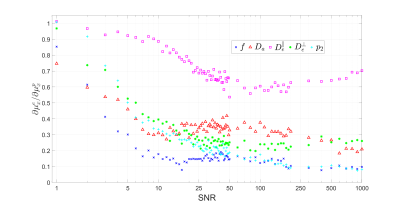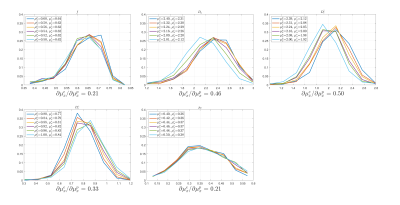Ying Liao1, Santiago Coelho1, Jelle Veraart1, Els Fieremans1, and Dmitry S. Novikov1
1Radiology, NYU School of Medicine, New York, NY, United States
1Radiology, NYU School of Medicine, New York, NY, United States
Here we quantify the effect of the training set on the popular diffusion model, the Standard Model of diffusion in the white matter, as function of signal-to-noise ratio, in simulations and in vivo.

Figure.
3. Effect of prior distribution on parameter estimation of synthetic data.
The slope $$$\partial \mu_{x}^{e}/\partial\mu_{x}^{p}$$$ of linear regression
of parameter estimate mean $$$\mu_{x}^{e}$$$ with respect to the mean of prior distribution $$$\mu_{x}^{p}$$$ is plotted against SNR for each SM parameter. We see that the diffusivities are notably more sensitive to prior (and less to measurement) than $$$f$$$ and $$$p_2$$$.

Figure.
4. Histogram of estimated parameters with different prior distributions for in-vivo data.
Histograms of each parameter estimated by polynomial regression trained by
different prior distributions are plotted for in-vivo data. Mean of the prior
distribution $$$\mu_{x}^{p}$$$ and the estimate mean $$$\mu_{x}^{e}$$$ of the
same parameter are provided in the legend for every SM parameter, while the slope $$$\partial\mu_{x}^{e}/\partial\mu_{x}^{p}$$$
is written under each subfigure.